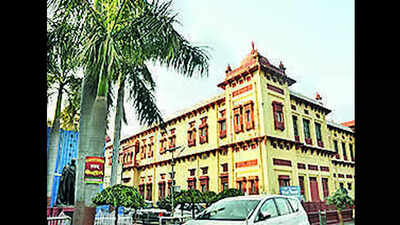- News
- City News
- patna News
- Archaeological excavation at Patna Museum to be started soon: Official
Archaeological excavation at Patna Museum to be started soon: Official

The museum has prepared a layout for the first phase of excavation after getting approval from the Archaeological Survey of India (ASI).
PATNA: The archaeological excavation work at Patna Museum will begin from this week with the technical support from Bihar Heritage Development Society (BHDS). The site was chosen for excavation after ancient ruins were found on the premises of the museum during the soil-digging work for construction of a fountain in 1996. The ruins were also found near the walls on the south-eastern side of the building.
The expert team will carry out the excavation work under the supervision of additional director of the museum, Vimal Tiwari.
The museum has prepared a layout for the first phase of excavation after getting approval from the Archaeological Survey of India (ASI). The museum has prepared a layout for the first phase of excavation after getting approval from the Archaeological Survey of India (ASI). The excavation work was formally inaugurated by CM Nitish Kumar on May 2.
Tiwari said all preparations have been made for the live archaeological digging so that the visitors can see how the excavation work is being done and how to preserve the unearthed ruins and ancient relics.
“We have identified the places for excavation where structural activities and ruins were found during construction work. Terracotta potteries and small balls dating back to 2,500-3,000 years ago were also found. In the first phase, excavation will be done by keeping the monsoon season in mind. The work will begin from the south-eastern side, which is near the front garden,” he said.
“The Patna Museum will carry out the work in collaboration with the BHDS. We normally cover the entire site or feature after excavation. However, we will leave the site open in this case. If ancient relics are be unearthed, conservation work will be done at the site for public viewing. A shade will be put up and the relics will be showcased,” Tiwari added.
He added GPR survey would also be carried out at the museum to detect possible ancient structures and ruins buried deep in the ground.
According to officials, the expert team will make two trenches of 10x10 feet at two earmarked spots. In the initial phase, the team will carry out the vertical excavation in which the archeologists may use test units to identify or remove strata.
The expert team will carry out the excavation work under the supervision of additional director of the museum, Vimal Tiwari.
The museum has prepared a layout for the first phase of excavation after getting approval from the Archaeological Survey of India (ASI). The museum has prepared a layout for the first phase of excavation after getting approval from the Archaeological Survey of India (ASI). The excavation work was formally inaugurated by CM Nitish Kumar on May 2.
Tiwari said all preparations have been made for the live archaeological digging so that the visitors can see how the excavation work is being done and how to preserve the unearthed ruins and ancient relics.
“We have identified the places for excavation where structural activities and ruins were found during construction work. Terracotta potteries and small balls dating back to 2,500-3,000 years ago were also found. In the first phase, excavation will be done by keeping the monsoon season in mind. The work will begin from the south-eastern side, which is near the front garden,” he said.
“The Patna Museum will carry out the work in collaboration with the BHDS. We normally cover the entire site or feature after excavation. However, we will leave the site open in this case. If ancient relics are be unearthed, conservation work will be done at the site for public viewing. A shade will be put up and the relics will be showcased,” Tiwari added.
He added GPR survey would also be carried out at the museum to detect possible ancient structures and ruins buried deep in the ground.
According to officials, the expert team will make two trenches of 10x10 feet at two earmarked spots. In the initial phase, the team will carry out the vertical excavation in which the archeologists may use test units to identify or remove strata.
FOLLOW US ON SOCIAL MEDIA
FacebookTwitterInstagramKOO APPYOUTUBE
Looking for Something?

Start a Conversation
end of article










